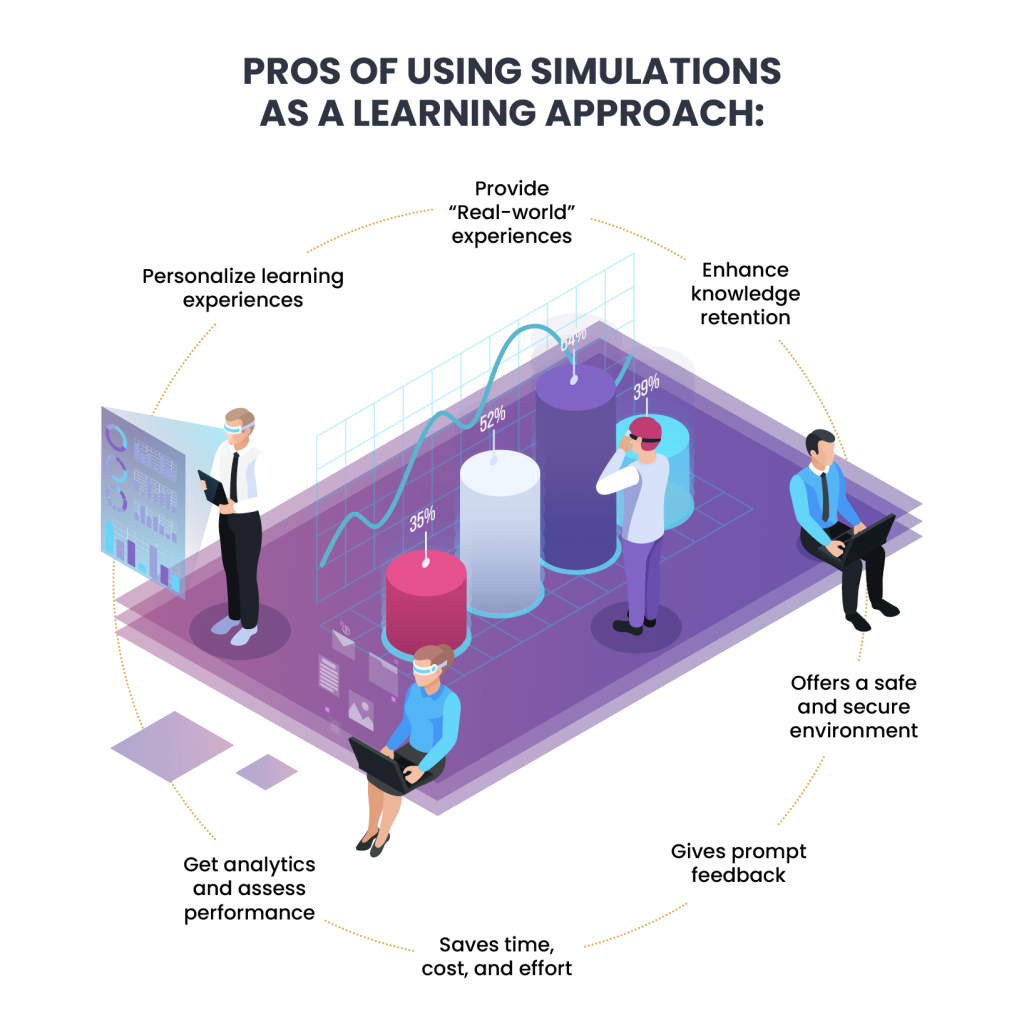Simulated training has been proven to be a potent learning tool. It puts the user in an experience that teaches them crucial abilities that they may apply in a number of circumstances. They give workers real-world experiences in demanding settings where they may act out scenarios safely and apply the “learn by doing” principle.
“For the things we have to learn before we can do them, we learn by doing them.” ― Aristotle
Simulation-based learning is becoming more popular due to technology developments and better knowledge of how people perceive challenges. Simulation-based learning has increased workers’ understanding and retention, competencies, and overall job productivity.
According to various researches, simulation training produces the best learning results. In the context of the learner’s growth and work function, it offers an interactive, realistic environment. The several benefits of simulation-based learning have rendered it one of the most successful corporate training methods in use today.
So, the question arises, why do simulations work, and why it is considered the most effective learning methods currently?
Benefits of simulation-based training in the modern workplace
An organization may evaluate the effectiveness of its workers’ competencies in a simulation-based learning environment without endangering its standing in the industry. It provides a perfect way for managers to assess how successfully their staff members use their talents and make decisions in the context of simulated real-life events. Some of the reasons why simulation is the preferred learning technique are:

1.Delivers lifelike experiences and context via application
One of the biggest reasons why simulations work is because of its ability to provide context through its applicability. As employers don’t offer their workers access to real-world situations where they may test their knowledge and skills, training programs frequently fail to produce the anticipated outcomes. Due to simulation-based training, learners are given the opportunity to “play through” particular scenarios in an interactive training environment.
“I hear and I forget. I see and I remember. I do and I understand.” ― Confucius
Simulation-based training offers an interactive and engaging framework. Learners who train via simulation have a better level of interest, understanding, and personal participation in their training than those who go through other training methods. Employees that are put through a simulation environment to evaluate their abilities can assess the effectiveness of their efforts and see the need for remedial action.
2.Knowledge retention
Interactive simulation-based training is the most effective when it comes to knowledge retention due to the application of the “learn by doing” principle. Employees participating in simulation training get the knowledge, self-assurance, and control necessary to navigate challenging scenarios successfully.
“The only source of knowledge is experience.” ― Albert Einstein
The more senses utilized during learning and the more actively the learner participates, the higher the learning retention improves. Simulation-based training promotes the application of knowledge during training, making it simpler to apply again after training. As a result of this approach, employees find it more difficult to forget what they’ve learned. Simply said, we learn better via action than we do from reading, hearing, or watching.
3.Low-risk “safety” environment
Through simulation-based training, individuals may train under those circumstances that are considered to be dangerous and costly. Employees are given limitless chances while in a safe setting during simulation training.
“Of course, learning is strengthened and solidified when it occurs in a safe, secure, and normal environment.” ― Jean-Bertrand Aristide
The company may create training for its workforce and assess their performance in business-specific scenarios with simulation-based training. As a result, by lowering these risks, workers develop their confidence more quickly. They can remember training efficiently by learning from prior errors made in a risk-free training environment.
4.Instant feedback
In simulation-based training, learners may hone their problem-solving abilities and benefit from feedback without endangering anybody or anything. They can reflect on their decisions and results, which helps them enhance their judgment and problem-solving skills.
“True intuitive expertise is learned from prolonged experience with good feedback on mistakes.” ― Daniel Kahneman
Instant feedback that may be automatically given is helpful for compliance and evaluation purposes. The feedback is given right after the training, which further increases the learning impact on the learner. In this manner, mistakes are prevented from being kept over the long term, while the retention of correct actions is maximized.
5.Time and cost-efficient
Businesses don’t want to spend much money and time on training programs; they prefer to have the training finished quickly and affordably. The time and money required for staff training may be significantly decreased by using simulation training, which can help businesses avoid paying for training locations or employee travel and lodging.
“We need to bring learning to people instead of people to learning.” ― Elliot Masie
Simulation training programs increase retention and use practical, hands-on methods that help the workforce become proficient with new competencies and technologies more quickly and efficiently.
6.Get real-time data and measure performance easily
Simulation-based training makes it simple to track progress, get outcomes, and analyze completion rates in order to compare personal performances. This makes it possible to identify areas for development among a wide group of learners.
“What gets measured, gets managed.” ― Peter Drucker
One can generate automatic reports and performance analytics that includes details about the training taken by learners, severity-level score, comparisons with other trainees, and other information.
7.Customized individual learning
A simulation-based training program can be customized according to the individual specific roles of the employees. Using a simulation-based training approach, it is possible to deliver personalized learning experiences to different employees and test their skills and abilities per their job functions, inevitably boosting their learning.
“Personalized learning is not what is done to the learner or about tailoring the learning. It is about helping each learner to identify and develop the skills they need to support and enhance their own learning so that agency and self-advocacy can be realized.” ― Kathleen McClaskey
Instructors can create simulations based on real-life difficulties faced by employees in business-specific scenarios. However, designing and creating simulations can be a complex process, but with EasySIM’s simulation-based platform, instructors can build performance-enhancing immersive learning simulations without any prior programming knowledge.
Conclusion
Through simulation-based training, businesses ensure effective learning by achieving best practices in business-specific scenarios. As simulation-based training continues to grow, essential competencies required to handle job-specific situations can be acquired and developed quickly. Therefore, simulation-based learning is an excellent strategy to master competencies linked to any job profession.






























